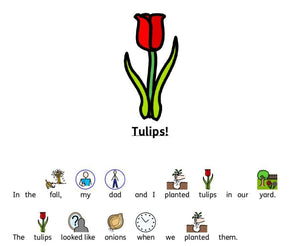Widgit Emergency Communication book for Deafblind Services

In Ontario, if a client of Deafblind Community Services (DBCS) Ontario is in an emergency situation, an Intervenor is called. Intervenors are trained professionals who help facilitate communication, access, and participation in all parts of daily life for people who are Deafblind: they are narrators, informers, guides, and communicators.
But in a situation where minutes or even seconds can mean the difference between life and death, what can be done to help with immediate communication with a first responder?
In 2014, Janine Tucker, at the time Provincial Project Coordinator for CNIB Deafblind Community Services in Ontario, had Bridges adapt the Widgit Health First Response Communication Book to be DBCS's Emergency Communication Kits.

The First Response Communication Book, by Widgit
Bridges Canadianized the original Widgit Health First Response Communication Book – localizing some of the imagery, terminology, not to mention the emergency number (911 not the British 999!) and such.
For the Kit, this book was printed in a large format along with braille: it is not uncommon for DBCS clients to have some useable sight. Attached to the front to this new large format First Response Communication Book was a Communication Alert Card, indicating that the person has sight and hearing loss, and their preferred communication method(s).

These Kits were then put into homes of deaf blind individuals across Ontario. Clients who register with DBCS’s Emergency Intervenor Service, are also able to request an Emergency Communication Kit.
As the DBCS website describes,
“The kits are designed to help facilitate basic and essential communication between the client and first responders or medical staff until an intervenor arrives. Clients are encouraged to keep the kit near the front entrance of their home so it can be easily located during an emergency. (…) Clients can use the Emergency Communication Kit and/or their own technical devices (i.e., a smartphone and refreshable braille display) to communicate with the first responder until an intervenor arrives. “
Ms. Tucker, now Manager of Deafblind Community Services in British Columbia, did many presentations on the books training local support teams, ambulance crews and other emergency responders and clients themselves. The local support teams, would then present to clients who took the Kits with them or placed them in a clients' residence.
Janine recalls that these books were very popular for clients and first responders. And, as is often the case with assistive technologies, in unexpected ways.
She remembers one incident where a fight broke out at a DBCS client’s residence. The police were able to use the Widgit First Response book to communicate with the person who was Deafblind, to deescalate the situation. An intervenor was dispatched to allow this client to give a witnesses statement.
In Janine's experience, the kits gave great peace of mind to DBCS clients.
And Paramedics were fascinated by them.

The unambiguous Widgit symbols of symptoms – diarrhoea, seizure etc – anatomy, and medical terms, always got a laugh from an audience of even the most seasoned ambulance crews!
But they also recognized that the clarity of the visuals made them an incredible resource and tool in aiding the sharing of vital information in an emergency. Not just for DBCS clients but with children, AAC users and those with injuries that could render someone temporarily non-verbal.
The Emergency Communication Kit was the inspiration for a subsequent initiative that placed similar communication binders with braille added in Ontraio hospitals.
Look for a future post about that project.
Images of Emergency Communication Book by CNIB Deafblind Community Services
- Bogdan Pospielovsky







Comments 0